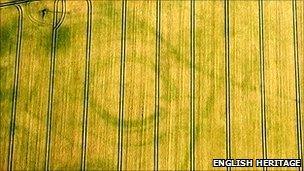Dry weather reveals archaeological 'cropmarks' in fields
- Published

English Heritage said sites which have been invisible since the drought of 1976 reappeared this summer
Hundreds of ancient sites have been discovered by aerial surveys, thanks to a dry start to the summer, English Heritage has said.
The surveys show marks made when crops growing over buried features develop at a different rate from those nearby.
The newly-discovered Roman and prehistoric settlements include a site near Bradford Abbas, Dorset.
The Roman camp was revealed in June after three sides became visible in sun-parched fields of barley.
The lightly-built defensive enclosure would have provided basic protection for Roman soldiers while on manoeuvres in the first century AD and is one of only four discovered in the south west of England, English Heritage said.
The dry conditions also allowed well-known sites to be photographed in greater detail.
Bumper year
Newton Kyme, near Tadcaster, North Yorkshire, was shown to not only be home to a Roman fort dating back nearly 2,000 years but also a larger, stronger defence built in 290AD.
English Heritage senior investigator Dave MacLeod said: "It's hard to remember a better year.
"Cropmarks are always at their best in dry weather, but the last few summers have been a disappointment.
"This year we have taken full advantage of the conditions. We try to concentrate on areas that in an average year don't produce much archaeology."
Flights over the Holderness area of the East Riding proved particularly productive with about 60 new sites, mainly prehistoric, found in just one day including livestock and settlement enclosures.
English Heritage said some sites which have not been visible since the drought of 1976 reappeared this summer.